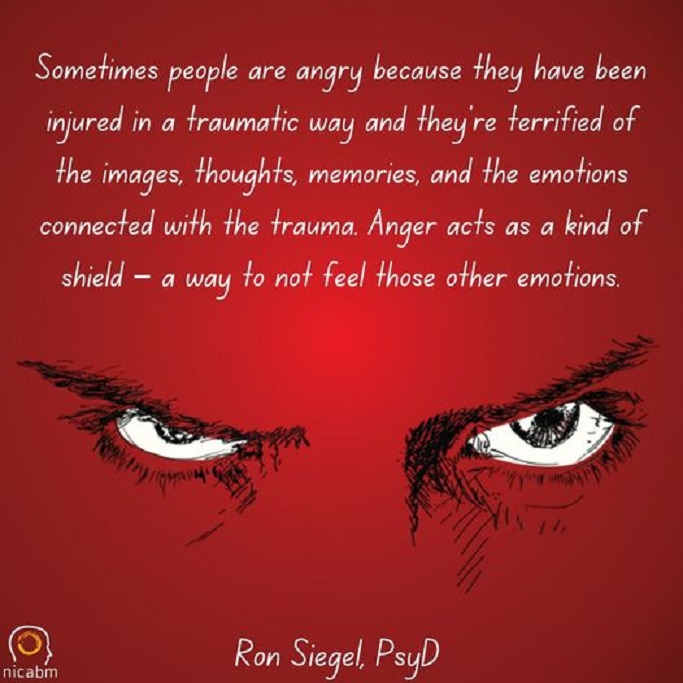If I could only remember everything I’ve read throughout my life, what wisdom I could spout now.
Unfortunately my memory spits and sputters like an asthmatic lawnmower engine proving it has just enough spark to announce important potential to the situation at hand, but not enough cranking power to keep the entire thought moving forward toward the desired destination; or you can’t cut much grass with an asthmatic mower.
Anyway, when I saw the image and thought above I wanted to offer a good reference book that described how we use anger to mask so many of our inner vulnerabilities, like feelings of grief, helplessness, fear, sadness, loneliness, and uncertainty. And of course now I can’t recall the book itself that described the situations or the author who conducted the study, but it had to do with helping veterans with severe trauma episodes and using EMDR to diffuse the energies of the most traumatic memories. (O’Hanlon’s books are good reference books along those lines, but this one wasn’t him.)
The gist of the thought was this: None of us like to feel vulnerable or in need of help from others to simply get on with our daily lives—just to make it through the day from one moment to the next, or from one day to the day after that. So when we feel like we might be internally shaky and/or falling apart emotionally, we tend to self-protectively regroup in our minds and shift our emotional states to the strongest emotion we can muster to better solidify our forward momentum; and that emotion is often ANGER.
Nothing pulls you out of a miserable funk faster than being ticked off over someone else’s behavior or thoughtless words/actions. It refocuses your attention and efforts toward protecting your more vulnerable self, and directing more hostile energies and intentions at any others daring to cross your path.
Anger is essentially a great ‘refocusing agent’. It provides the mental clarity to aim our uncertain, wobbly intentions toward some forward momentum and away from the stagnant hole we were stuck in before we engaged our fury over most anything that matched our momentary need to strike out against our own feelings of complete helplessness.
Do you know people who walk around pissed off most of the time? Guess what they are likely hiding beneath that hostile exterior? They could be hiding feelings of victimization, or inadequacy, or raw pain, or never-ending memories of loss or injustice; but they don’t want you to get close enough to them to see or feel it radiating from their quivering bodies, so instead they mask it with a ferocious fierceness and an acidic glare that can peel paint off a tool shed with a single glance.
They literally beam these words in front of them as they approach you: STAY AWAY FROM ME! CAN’T YOU SEE I’M DANGEROUS?!! And you do stay away for sanity-preservation and personal safety. That’s what anger can do—it warns, then threatens, and lastly lashes out. “Approach at your own risk!” it visually claims. “Are you really brave enough to confront me?!!”
But most of the time the angry person is simply wallowing in pain or shivering in perpetual fear or sinking ever lower in deep, deep sadness, but they don’t want you to see that vulnerability in them. Vulnerability represents ‘weakness;’ and weak people don’t last long in this combative world.
If you are intrigued enough to learn more about all of this, hopefully you’ll run across the book about a male therapist who helped many veterans deal with their debilitating PTSD using EMDR techniques (Eye Movement Desensitization and Reprocessing); or I found a good book on my shelves about combining brain science with psychotherapy called Mindsight: The New Science of Personal Transformation by Daniel J. Siegel, M.D., that gives a comprehensive explanation to how the brain actually functions in various situations; and how we can take control of our own lives again once we better understand how previously we were auto-reacting to the world around us without assessing WHY we were doing so. It’s worth a read. (My book is full of underlines and side notes so it must have been interesting enough to have held my attention.) Looks like he also writes of similar therapy situations that I mentioned dealing with veteran’s PTSD. Hope it fits your needs to learn more about the subject matter.
As an energy worker, I know that emotions are energy spurts, bursts, or leaks, so better understanding our range of emotions helps us to raise our personal energy frequencies higher out of the doom and gloom range; and to make our lives and the lives of those around us, more desirable and pleasant for all.
You may not be able to prevent how others treat you, but you can choose to react or respond to that treatment in a manner that best suits your own purposes for living a more loving and peaceful life. That is a choice worth intentionally making.
